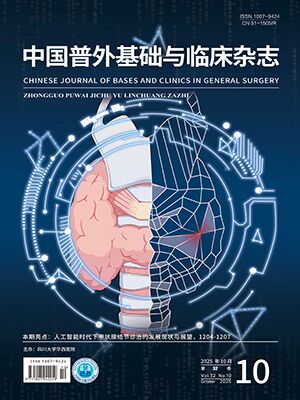| 1. |
黄理宾, 黄秋实, 杨烈. 全球及中国的结直肠癌流行病学特征及防治: 2022《全球癌症统计报告》解读. 中国普外基础与临床杂志, 2024, 31(5): 530-537.
|
| 2. |
姚一菲, 孙可欣, 郑荣寿. 《2022全球癌症统计报告》解读: 中国与全球对比. 中国普外基础与临床杂志, 2024, 31(7): 769-780.
|
| 3. |
梁国刚, 蔡克, 马琳, 等. 重度LARS的影响因素分析. 结直肠肛门外科, 2020, 26(5): 561-565.
|
| 4. |
Nguyen TH, Chokshi RV. Low anterior resection syndrome. Curr Gastroenterol Rep, 2020, 22(10): 48. doi: 10.1007/s11894-020-00785-z.
|
| 5. |
Huang MJ, Ye L, Yu KX, et al. Development of prediction model of low anterior resection syndrome for colorectal cancer patients after surgery based on machine-learning technique. Cancer Med, 2023, 12(2): 1501-1519.
|
| 6. |
Pieniowski EHA, Palmer GJ, Juul T, et al. Low anterior resection syndrome and quality of life after sphincter-sparing rectal cancer surgery: A long-term longitudinal follow-up. Dis Colon Rectum, 2019, 62(1): 14-20.
|
| 7. |
胡海燕, 孙佳男, 张晴, 等. 直肠癌低位前切除综合征发展轨迹的潜在类别及预测因素分析. 中国护理管理, 2024, 24(6): 819-824.
|
| 8. |
Keane C, Wells C, O’Grady G, et al. Defining low anterior resection syndrome: a systematic review of the literature. Colorectal Dis, 2017, 19(8): 713-722.
|
| 9. |
王璋, 邵胜利, 刘鹭, 等. 腹腔镜直肠癌前切除术后低位前切除综合征的发生率和症状学分析. 中华胃肠外科杂志, 2024, 27(1): 69-74.
|
| 10. |
Al-Rashid F, Robitaille S, Liberman AS, et al. Trajectory of change of low anterior resection syndrome over time after restorative proctectomy for rectal adenocarcinoma. Tech Coloproctol, 2022, 26(3): 195-203.
|
| 11. |
卜旻淳. 直肠癌保肛根治术后低位前切除综合征危险因素分析及列线图预测模型构建. 合肥: 安徽医科大学外科学(普外), 2022.
|
| 12. |
Morgan RD, Youssi BW, Cacao R, et al. Random forest prognostication of survival and 6-month outcome in pediatric patients following decompressive craniectomy for traumatic brain injury. World Neurosurg, 2025, 193: 861-867.
|
| 13. |
冯清, 贺培凤. 基于随机森林模型的耐碳青霉烯类鲍曼不动杆菌性呼吸机相关性肺炎风险预测模型的构建. 护理研究, 2024, 38(19): 3410-3416.
|
| 14. |
Wang Z, Shao SL, Liu L, et al. Machine learning model for prediction of low anterior resection syndrome following laparoscopic anterior resection of rectal cancer: A multicenter study. World J Gastroenterol, 2023, 29(19): 2979-2991.
|
| 15. |
汪晓东, 李立. 数据库建设第一部分: 个人数据的标签与结构化. 中国普外基础与临床杂志, 2019, 26(3): 335-342.
|
| 16. |
汪晓东, 由屹先, 余其澳, 等. 数据库建设第九部分: 结直肠癌新辅助治疗的标签与结构化. 中国普外基础与临床杂志, 2021, 28(6): 799-804.
|
| 17. |
汪晓东, 林容若, 刘健博, 等. 数据库建设第七部分: 结直肠癌手术特征的标签与结构化(一). 中国普外基础与临床杂志, 2020, 27(9): 1150-1152.
|
| 18. |
汪晓东, 刘健博, 李立. 数据库建设第五部分: 结直肠癌的肿瘤特征—模块的设计(一). 中国普外基础与临床杂志, 2020, 27(3): 345-349.
|
| 19. |
张峻岭, 董洁晶, 吴涛, 等. 直肠癌保肛根治术后低位前切除综合征危险因素的列线图分析. 中华普通外科杂志, 2021, 36(2): 81-85.
|
| 20. |
Yan M, Lin Z, Wu Z, et al. A predictive nomogram model for low anterior resection syndrome after rectal cancer resection. ANZ J Surg, 2022, 92(12): 3224-3231.
|
| 21. |
Emmertsen KJ, Laurberg S. Low anterior resection syndrome score: development and validation of a symptom-based scoring system for bowel dysfunction after low anterior resection for rectal cancer. Ann Surg, 2012, 255(5): 922-928.
|
| 22. |
曹兰玉, 魏力, 王春梅. 直肠癌前切除综合征评分量表的汉化及信效度评价. 中国实用护理杂志, 2013, 29(27): 69-72.
|
| 23. |
Le TT, Kim H, Kang H, et al. Classification and explanation for intrusion detection system based on ensemble trees and SHAP method. Sensors (Basel), 2022, 22(3): 1154. doi: 10.3390/s22031154.
|
| 24. |
孟祥勇, 秦嘉怡, 陈文生. 基于机器学习的早期胃癌淋巴结转移预测模型构建与验证. 陆军军医大学学报, 2024, 46(21): 2432-2442.
|
| 25. |
岳中屹, 李秀庚, 张敏, 等. 建立预测直肠癌术后前切除综合征的列线图模型. 现代肿瘤医学, 2021, 29(23): 4141-4145.
|
| 26. |
Miyo M, Akizuki E, Okuya K, et al. Diagnosis and treatment of low anterior resection syndrome. J Anus Rectum Colon, 2025, 9(1): 1-9.
|
| 27. |
Croese AD, Lonie JM, Trollope AF, et al. A meta-analysis of the prevalence of low anterior resection syndrome and systematic review of risk factors. Int J Surg, 2018, 56: 234-241.
|
| 28. |
余可欣, 罗绰, 汪晓东, 等. 直肠癌术后肛门功能康复的研究进展. 中华结直肠疾病电子杂志, 2021, 10(3): 298-301.
|
| 29. |
Sturiale A, Martellucci J, Zurli L, et al. Long-term functional follow-up after anterior rectal resection for cancer. Int J Colorectal Dis, 2017, 32(1): 83-88.
|
| 30. |
Koda K, Yamazaki M, Shuto K, et al. Etiology and management of low anterior resection syndrome based on the normal defecation mechanism. Surg Today, 2019, 49(10): 803-808.
|
| 31. |
理纪, 周世云. 低位直肠癌患者腹腔镜辅助经肛全直肠系膜切除术术后排便功能观察及其相关影响因素分析. 实用癌症杂志, 2022, 37(3): 471-473.
|
| 32. |
宋美璇, 刘东, 徐林霞, 等. 腹腔镜辅助经肛全直肠系膜切除术后患者低位前切除综合征的发生率及影响因素的Meta分析. 胃肠病学和肝病学杂志, 2023, 32(5): 558-563.
|
| 33. |
郭帆, 韩斌, 黄琳凯, 等. 腹腔镜直肠癌保肛根治术后低位前切除综合征的发生及影响因素分析. 华中科技大学学报(医学版), 2021, 50(2): 194-200.
|
| 34. |
Nikolouzakis TK, Mariolis-Sapsakos T, Triantopoulou C, et al. Detailed and applied anatomy for improved rectal cancer treatment. Ann Gastroenterol, 2019, 32(5): 431-440.
|
| 35. |
Bohlok A, Mercier C, Bouazza F, et al. The burden of low anterior resection syndrome on quality of life in patients with mid or low rectal cancer. Support Care Cancer, 2020, 28(3): 1199-1206.
|
| 36. |
Breiman L. Random forests. Machine Learning, 2001, 45(1): 5-32.
|
| 37. |
韩玉, 施海龙, 曲波, 等. 随机森林方法在医学中的应用. 中国预防医学杂志, 2014, 15(1): 79-81.
|
| 38. |
Hanko M, Grendár M, Snopko P, et al. Random forest-based prediction of outcome and mortality in patients with traumatic brain injury undergoing primary decompressive craniectomy. World Neurosurg, 2021, 148: e450-e458. doi: 10.1016/j.wneu.2021.01.002.
|
| 39. |
Song Y, Yin Z, Zhang C, et al. Random forest classifier improving phenylketonuria screening performance in two Chinese populations. Front Mol Biosci, 2022, 9: 986556. doi: 10.3389/fmolb.2022.986556.
|
| 40. |
海瑞, 王慧, 张蓉, 等. 基于机器学习的老年慢性心力衰竭病人衰弱风险预测模型的构建. 护理研究, 2024, 38(12): 2103-2109.
|
| 41. |
杨芳, 郄淑文, 杨丽, 等. 基于机器学习的腹膜透析患者早发性腹膜透析相关性腹膜炎风险预测模型的构建. 中华现代护理杂志, 2025, 31(6): 778-783.
|




